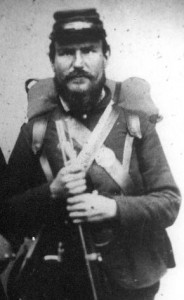 On July 2, 1863 at 5:40AM Isaac Taylor recorded in his diary that his regiment, the First Minnesota Volunteer Infantry Regiment, had arrived at Gettysburg. “Order from Gen. [John] Gibbon read to us in which he says this is to be the great battle of the war & that any soldier leaving ranks without leave will be instantly put to death,” as Taylor noted. By the end of the day 215 of the 262 soldiers in the regiment had been killed or wounded. While Isaac died, his brother, Patrick Henry Taylor, made it out of the battle without injury. After Patrick buried his brother, he added the final entry to the diary – Isaac had been “killed by a shell about sunset” and his grave was located “[about] a mile South of Gettysburg.” Four other Taylor brothers also served in other Union regiments during the Civil War. While Jonathan (Second Minnesota Battery of Light Artillery), Danford (Twelfth Illinois Cavalry), and Samuel (102nd Illinois Infantry) survived the war, Judson was in Company K of the Eleventh Illinois Cavalry when he died at Vicksburg on December 1, 1864. Isaac’s Taylor’s diary was published in the Minnesota History Magazine in 4 sections. You can download them as a PDF file: Part 1 ; Part 2 ; Part 3 ; Part 4. Several historians have studied the First Minnesota Volunteer Infantry, including John Quinn Imholte’s The First Volunteers; History of the First Minnesota Volunteer Regiment, 1861-1865 (1963), Richard Moe’s Last Full Measure: The Life and Death of the First Minnesota Volunteers (1993), and Brian Leehan’s Pale Horse at Plum Run: The First Minnesota at Gettysburg (2004). You can read another account of the regiment’s actions in James A. Wright’s No More Gallant a Deed: a Civil War Memoir of the First Minnesota Volunteers (2001).
On July 2, 1863 at 5:40AM Isaac Taylor recorded in his diary that his regiment, the First Minnesota Volunteer Infantry Regiment, had arrived at Gettysburg. “Order from Gen. [John] Gibbon read to us in which he says this is to be the great battle of the war & that any soldier leaving ranks without leave will be instantly put to death,” as Taylor noted. By the end of the day 215 of the 262 soldiers in the regiment had been killed or wounded. While Isaac died, his brother, Patrick Henry Taylor, made it out of the battle without injury. After Patrick buried his brother, he added the final entry to the diary – Isaac had been “killed by a shell about sunset” and his grave was located “[about] a mile South of Gettysburg.” Four other Taylor brothers also served in other Union regiments during the Civil War. While Jonathan (Second Minnesota Battery of Light Artillery), Danford (Twelfth Illinois Cavalry), and Samuel (102nd Illinois Infantry) survived the war, Judson was in Company K of the Eleventh Illinois Cavalry when he died at Vicksburg on December 1, 1864. Isaac’s Taylor’s diary was published in the Minnesota History Magazine in 4 sections. You can download them as a PDF file: Part 1 ; Part 2 ; Part 3 ; Part 4. Several historians have studied the First Minnesota Volunteer Infantry, including John Quinn Imholte’s The First Volunteers; History of the First Minnesota Volunteer Regiment, 1861-1865 (1963), Richard Moe’s Last Full Measure: The Life and Death of the First Minnesota Volunteers (1993), and Brian Leehan’s Pale Horse at Plum Run: The First Minnesota at Gettysburg (2004). You can read another account of the regiment’s actions in James A. Wright’s No More Gallant a Deed: a Civil War Memoir of the First Minnesota Volunteers (2001).
10
Dec
10
Isaac L. Taylor at Gettysburg
Posted by sailerd Published in Civil War (1861-1865), Letters & Diaries Themes: Battles & Soldiers6
Dec
10
New York Times Features House Divided Image
Posted by sailerd Published in Antebellum (1840-1861), Images Themes: Carlisle & Dickinson, Contests & Elections A blog post by Jamie Malanowski in the New York Times’ “Disunion” series featured this political cartoon from House Divided’s image collection. In this entry Malanowski explores how President James Buchanan addresses the secession crisis in his last State of the Union message to Congress in December 1860. “Buchanan at long last waded into the secession crisis…in the manner of a cranky grandfather who has found a pleasant afternoon nap spoiled by a household of fractious children,” as Malanowski describes. (Read the full text of Buchanan’s State of the Union here).This post is part of a new series that, as the New York Times explains, “revisits and reconsiders America’s most perilous period — using contemporary accounts, diaries, images and historical assessments to follow the Civil War as it unfolded.” Other entries include “Two Communiqués, and a Commander’s Dilemma,” “Silencing the Fanatics,” and “An American Thanksgiving, Skewered and Roasted.” You can also learn more about Buchanan from his profile on House Divided or at the James Buchanan Resource Center.
A blog post by Jamie Malanowski in the New York Times’ “Disunion” series featured this political cartoon from House Divided’s image collection. In this entry Malanowski explores how President James Buchanan addresses the secession crisis in his last State of the Union message to Congress in December 1860. “Buchanan at long last waded into the secession crisis…in the manner of a cranky grandfather who has found a pleasant afternoon nap spoiled by a household of fractious children,” as Malanowski describes. (Read the full text of Buchanan’s State of the Union here).This post is part of a new series that, as the New York Times explains, “revisits and reconsiders America’s most perilous period — using contemporary accounts, diaries, images and historical assessments to follow the Civil War as it unfolded.” Other entries include “Two Communiqués, and a Commander’s Dilemma,” “Silencing the Fanatics,” and “An American Thanksgiving, Skewered and Roasted.” You can also learn more about Buchanan from his profile on House Divided or at the James Buchanan Resource Center.
3
Dec
10
Lincoln’s First Inaugural Address – “A Scurvy Trick”
Posted by sailerd Published in Antebellum (1840-1861), Historic Periodicals, Recent Scholarship Themes: Contests & Elections Newspapers across the country published President Abraham Lincoln’s first Inaugural Address in March 1861, but not all included the correct version. Editors in New Orleans had, as the Chicago (IL) Tribune explained, “horribly botched” the speech. Not only had “words [been] altered,” but sentences [were] cut in two in the middle and other sentences [were] run together.” As a result, Lincoln’s speech had been turned “into a ridiculous jumble and mass of nonsense.” While Tribune editor Joseph Medill knew from experience that “a long document [rarely] is transmitted over the wires without undergoing more or less transformation,” he believed in this case that New Orleans editors deliberately included errors in order to further their disunion agenda. “Evidently the conductors of the secession press are unwilling that the people whom they have hurried into rebellion without a cause, shall have the opportunity of learning the truth or of listening to exhortations of loyalty,” as Medill concluded. The only “parallel instance of meanness” that Medill could recall had occurred during the Lincoln-Douglas debates in 1858. As the Tribune noted in September 1858, Democratic editors told their reporters “to report [Lincoln’s speeches] incorrectly, to leave out words and sentences, and otherwise to mutilate his arguments so as to destroy their force and effect on the minds of those who read the Douglas papers.” You can read more about the Lincoln-Douglas debates in Michael Burlingame’s “Mucilating Douglas and Mutilating Lincoln: How Shorthand Reporters Covered the Lincoln-Douglas Debates of 1858,” Lincoln Herald (1994) and Allen C. Guelzo’s Lincoln and Douglas: The Debates That Defined America (2008). As for President Lincoln’s First Inaugural Address, see chapter 3 of Douglas L. Wilson’s Lincoln’s Sword: The Presidency and the Power of Words (2006).
Newspapers across the country published President Abraham Lincoln’s first Inaugural Address in March 1861, but not all included the correct version. Editors in New Orleans had, as the Chicago (IL) Tribune explained, “horribly botched” the speech. Not only had “words [been] altered,” but sentences [were] cut in two in the middle and other sentences [were] run together.” As a result, Lincoln’s speech had been turned “into a ridiculous jumble and mass of nonsense.” While Tribune editor Joseph Medill knew from experience that “a long document [rarely] is transmitted over the wires without undergoing more or less transformation,” he believed in this case that New Orleans editors deliberately included errors in order to further their disunion agenda. “Evidently the conductors of the secession press are unwilling that the people whom they have hurried into rebellion without a cause, shall have the opportunity of learning the truth or of listening to exhortations of loyalty,” as Medill concluded. The only “parallel instance of meanness” that Medill could recall had occurred during the Lincoln-Douglas debates in 1858. As the Tribune noted in September 1858, Democratic editors told their reporters “to report [Lincoln’s speeches] incorrectly, to leave out words and sentences, and otherwise to mutilate his arguments so as to destroy their force and effect on the minds of those who read the Douglas papers.” You can read more about the Lincoln-Douglas debates in Michael Burlingame’s “Mucilating Douglas and Mutilating Lincoln: How Shorthand Reporters Covered the Lincoln-Douglas Debates of 1858,” Lincoln Herald (1994) and Allen C. Guelzo’s Lincoln and Douglas: The Debates That Defined America (2008). As for President Lincoln’s First Inaugural Address, see chapter 3 of Douglas L. Wilson’s Lincoln’s Sword: The Presidency and the Power of Words (2006).
1
Dec
10
Journal Divided featured on C-SPAN
Posted by sailerd Published in Antebellum (1840-1861), Recent Scholarship, Video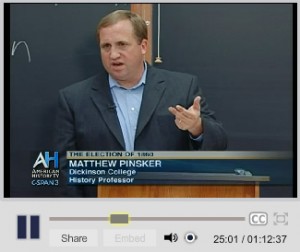 “American History TV” on C-SPAN 3 featured an episode inside the classroom of House Divided Project co-director Matthew Pinsker. C-SPAN cameras followed Pinsker as he led a discussion about Abraham Lincoln and the election of 1860 for a class at Dickinson College in Carlisle, PA. During the session, Pinsker premiered a documentary short film recently created for Journal Divided. “Honest Abe” is one of six videos created to support new interactive essays based on excerpts from the unedited manuscript of Michael Burlingame’s Abraham Lincoln: A Life (2008). Other essays include “Writing Lincoln’s Lives,” “Railsplitter,” and “Make No Contracts.”
“American History TV” on C-SPAN 3 featured an episode inside the classroom of House Divided Project co-director Matthew Pinsker. C-SPAN cameras followed Pinsker as he led a discussion about Abraham Lincoln and the election of 1860 for a class at Dickinson College in Carlisle, PA. During the session, Pinsker premiered a documentary short film recently created for Journal Divided. “Honest Abe” is one of six videos created to support new interactive essays based on excerpts from the unedited manuscript of Michael Burlingame’s Abraham Lincoln: A Life (2008). Other essays include “Writing Lincoln’s Lives,” “Railsplitter,” and “Make No Contracts.”
You can watch the full 75-minute episode on C-SPAN’s website.
29
Nov
10
Cleveland (OH) Herald & the USCT
Posted by sailerd Published in Civil War (1861-1865), Historic Periodicals Themes: Battles & Soldiers After Confederates shelled Fort Sumter on April 12, 1861, President Abraham Lincoln called for volunteers to restore order. Many northerners responded and rushed to create volunteer regiments. Yet when African Americans offered to serve, northern officials turned them down. After Ohio Governor William Dennison denied a request, the Cleveland Herald called his decision “eminently proper.” While the Herald did not want to “impugn the motives of those…who wish to raise military companies,” the editor believed that “the enlistment of colored troops would dampen, if not kill, the ardor of the masses now rushing to arms.” The Herald was also concerned that such action “would embitter the present contest and render utterly hopeless any prospect of peace.” Two years later, however, the War Department authorized the creation of the United States Colored Troops. Within months new USCT regiments were participating in battles, including those at Milliken’s Bend and Fort Wagner. The Cleveland Herald joined other northern newspapers which changed their editorial stance on African Americans in the military and even supported the call for USCT troops to receive pay equal to white soldiers. After Congress passed the necessary legislation in 1864, the Herald noted that “this simple act of justice has been quite too long delayed.” Joseph T. Glatthaar’s Forged in Battle: The Civil War Alliance of Black Soldiers and White Officers (1990), Howard C. Westwood’s Black Troops, White Commanders and Freedmen During the Civil War (1992), and John David Smith’s Black Soldiers in Blue (2002).
After Confederates shelled Fort Sumter on April 12, 1861, President Abraham Lincoln called for volunteers to restore order. Many northerners responded and rushed to create volunteer regiments. Yet when African Americans offered to serve, northern officials turned them down. After Ohio Governor William Dennison denied a request, the Cleveland Herald called his decision “eminently proper.” While the Herald did not want to “impugn the motives of those…who wish to raise military companies,” the editor believed that “the enlistment of colored troops would dampen, if not kill, the ardor of the masses now rushing to arms.” The Herald was also concerned that such action “would embitter the present contest and render utterly hopeless any prospect of peace.” Two years later, however, the War Department authorized the creation of the United States Colored Troops. Within months new USCT regiments were participating in battles, including those at Milliken’s Bend and Fort Wagner. The Cleveland Herald joined other northern newspapers which changed their editorial stance on African Americans in the military and even supported the call for USCT troops to receive pay equal to white soldiers. After Congress passed the necessary legislation in 1864, the Herald noted that “this simple act of justice has been quite too long delayed.” Joseph T. Glatthaar’s Forged in Battle: The Civil War Alliance of Black Soldiers and White Officers (1990), Howard C. Westwood’s Black Troops, White Commanders and Freedmen During the Civil War (1992), and John David Smith’s Black Soldiers in Blue (2002).
19
Nov
10
Election of 1860 – William Wilkins Letter
Posted by sailerd Published in Antebellum (1840-1861), Letters & Diaries Themes: Carlisle & Dickinson, Contests & Elections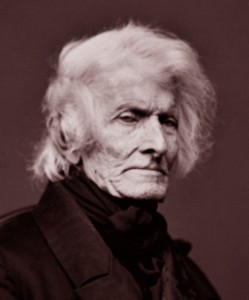 William Wilkins’ letter to James Webb, editor and publisher of the New York Courier and Enquirer, reveals an interesting view on some of the political perspectives that existed on the eve of the 1860 election. Wilkins, who graduated from Dickinson College in 1802, was a Pennsylvania Democratic politician who also served as Secretary of War in President John Tyler’s administration. While Wilkins had originally “intended to have told you something of myself,” he noted that Webb’s political “pamphlet has driven all such things out of my head and set if off ‘a wool gathering.’” Wilkins’ was not happy with Webb’s take on slavery. George Washington “never dreaming he was fighting for kidnapped Africans of the Lowest order of human beings,” Wilkins argued. Wilkins also believed that southerners should be allowed to bring slaves into any territory. “Where is the great right of migration?,” Wilkins asked. Yet Wilkins was careful to note that he did not count Webb among the radical abolitionists. “You must not suppose I include you…in [the] certain mad, fanatical category as full of political wickedness as was John Brown,” Wilkins explained. Wilkins hoped that sectional tensions would be resolved without resorting to disunion, as there could be no “secession, without pulling down the entire wonderfully and wildly constructed fabric” of the Union. While Wilkins’ wife asked him “to burn…this horrible letter,” he refused and sent it onto Webb. You can read the full text of this letter online at House Divided.
William Wilkins’ letter to James Webb, editor and publisher of the New York Courier and Enquirer, reveals an interesting view on some of the political perspectives that existed on the eve of the 1860 election. Wilkins, who graduated from Dickinson College in 1802, was a Pennsylvania Democratic politician who also served as Secretary of War in President John Tyler’s administration. While Wilkins had originally “intended to have told you something of myself,” he noted that Webb’s political “pamphlet has driven all such things out of my head and set if off ‘a wool gathering.’” Wilkins’ was not happy with Webb’s take on slavery. George Washington “never dreaming he was fighting for kidnapped Africans of the Lowest order of human beings,” Wilkins argued. Wilkins also believed that southerners should be allowed to bring slaves into any territory. “Where is the great right of migration?,” Wilkins asked. Yet Wilkins was careful to note that he did not count Webb among the radical abolitionists. “You must not suppose I include you…in [the] certain mad, fanatical category as full of political wickedness as was John Brown,” Wilkins explained. Wilkins hoped that sectional tensions would be resolved without resorting to disunion, as there could be no “secession, without pulling down the entire wonderfully and wildly constructed fabric” of the Union. While Wilkins’ wife asked him “to burn…this horrible letter,” he refused and sent it onto Webb. You can read the full text of this letter online at House Divided.
17
Nov
10
Election of 1860 – Cumberland County
Posted by sailerd Published in Antebellum (1840-1861), Images, Recent Scholarship Themes: Carlisle & Dickinson, Contests & ElectionsWhile Abraham Lincoln was elected “by one of the largest voter turnouts in United States history,” historian Phillip Shaw Paludan notes that “the Republican victory was entirely sectional.” Lincoln and Hannibal Hamblin did not receive any votes from the Deep South states. Yet divisions also existed within northern states, including Cumberland County, Pennsylvania. The election results for Carlisle reflected a deep divide in the community – while Republicans won the town (overall votes in Carlisle West Ward / East Ward), Democrats received the most votes overall in Carlisle District (For more details, see election return tables below). As for Cumberland County, Lincoln received 51.5% of the vote in Cumberland County. These results largely correspond with historians’ arguments about urban and rural voting patterns in the 1860 election. While “one might expect to find northern cities to have been stronghold of Republicanism,” David Potter argues that “Lincoln received much less support in the urban North than he did in the rural North.” Republicans received the most votes by far in the rural precincts of Cumberland County and came very close to losing Carlisle. One can see which precinct Lincoln’s party won in the map below — precincts that Republicans won have blank backgrounds. This map was originally published in John Wesley Weigel’s “Free Soil: The Birth of the Republican Party in Cumberland County,” Cumberland County History Journal (Summer 2000). The full article, along with other essays that explore the political history of the Whigs and Democrats in Cumberland County, are available on this post as PDF files.
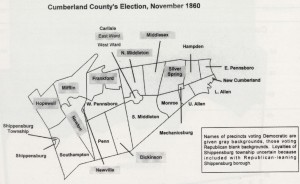
(Click on the map to see larger version)
In addition, you can click the “Continue Reading” link below to see the detailed election returns for Cumberland County, Carlisle District, and Newville District below –
continue reading "Election of 1860 – Cumberland County"
15
Nov
10
“Beyond the Log Cabin: Kentucky’s Abraham Lincoln”
Posted by sailerd Published in 19th Century (1840-1880), Historic Periodicals, Images, Letters & Diaries “Beyond the Log Cabin: Kentucky’s Abraham Lincoln” is a great online exhibit created by the Kentucky Historical Society. This interactive site includes manuscripts and artifacts from over 40 repositories nationwide and the content is divided into four overall categories – Themes, Timeline, Treasures, and Resources. Themes include topics such as “Frontier World of Abraham Lincoln,” “Lincoln’s Rise,” “Lincoln and Kentucky at War,” and “Remembering Lincoln: Then and Now.” Each one has a short essay as well as relevant documents, images, and other relevant artifacts. The Timeline section explores Lincoln’s life in Kentucky as well as how the state has commemorated the Sixteenth President after April 1865. The Treasures section allows visitors to explore all of the photographs, manuscripts, and other artifacts in an interactive display. Resources include a Teacher’s guide, a bibliography, and an essay originally published in the Kentucky Historical Society Chronicle.
“Beyond the Log Cabin: Kentucky’s Abraham Lincoln” is a great online exhibit created by the Kentucky Historical Society. This interactive site includes manuscripts and artifacts from over 40 repositories nationwide and the content is divided into four overall categories – Themes, Timeline, Treasures, and Resources. Themes include topics such as “Frontier World of Abraham Lincoln,” “Lincoln’s Rise,” “Lincoln and Kentucky at War,” and “Remembering Lincoln: Then and Now.” Each one has a short essay as well as relevant documents, images, and other relevant artifacts. The Timeline section explores Lincoln’s life in Kentucky as well as how the state has commemorated the Sixteenth President after April 1865. The Treasures section allows visitors to explore all of the photographs, manuscripts, and other artifacts in an interactive display. Resources include a Teacher’s guide, a bibliography, and an essay originally published in the Kentucky Historical Society Chronicle.
12
Nov
10
Cornelia Peake McDonald Journal
Posted by sailerd Published in Civil War (1861-1865), Letters & Diaries Themes: Women & Families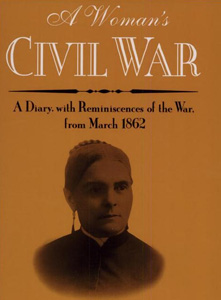 Winchester, Virginia in the Shenandoah Valley was arguably the most contested town of the Civil War. Depending on how you count, the community changed hands over seventy times during four years. Several women kept diaries, wrote remarkable letters or crafted post-war reminiscences. One of the best hybrid collections (part-diary/ part-recollection) comes from Cornelia Peake McDonald who wrote with great talent and behaved with outrageous defiance. After Union soldiers “threatened to come in and break up the furniture if breakfast was not immediately given them,” McDonald and her children prepared to defend their home – McDonald described how they “fastened down the windows and tried… to keep them from coming in at the door.” Raising children in a town like Winchester with lots of soldiers stationed in the vicinity also presented other challenges. After her son was arrested on the suspicion of throwing a snowball at a Union officer, McDonald observed that –
Winchester, Virginia in the Shenandoah Valley was arguably the most contested town of the Civil War. Depending on how you count, the community changed hands over seventy times during four years. Several women kept diaries, wrote remarkable letters or crafted post-war reminiscences. One of the best hybrid collections (part-diary/ part-recollection) comes from Cornelia Peake McDonald who wrote with great talent and behaved with outrageous defiance. After Union soldiers “threatened to come in and break up the furniture if breakfast was not immediately given them,” McDonald and her children prepared to defend their home – McDonald described how they “fastened down the windows and tried… to keep them from coming in at the door.” Raising children in a town like Winchester with lots of soldiers stationed in the vicinity also presented other challenges. After her son was arrested on the suspicion of throwing a snowball at a Union officer, McDonald observed that –
“I have to be constantly on the watch for fear of my boys doing something to provoke the persecution of the Yankees. Not long since I heard an explosion in the yard loud enough to create some alarm, and on hurrying out saw a squad of soldiers approaching the scene of action, thinking it was an alarm. The noise proceeded from a battery the boys had erected on the top of the cistern and had supplied it with guns they had manufactured out of musket barrels cut into lengths of eight or nine inches, and bored for a touch hole, then mounted on carriages of their own make. I had noticed them very busily engaged about the yard for some time but never dreamed what they were after.”
You can read other excerpts from McDonald’s diary on Google Books.
9
Nov
10
Kate Stone Journal
Posted by sailerd Published in Civil War (1861-1865), Letters & Diaries Themes: Slavery & Abolition, US & the World, Women & Families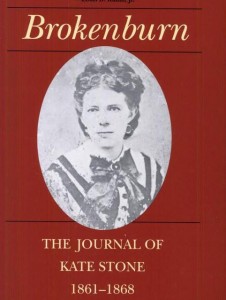 Kate Stone was twenty-years-old when Fort Sumter fell to Confederate forces. She was thrilled. Stone was an ardent southern nationalist from Louisiana who lived on a large plantation (Brokenburn) with many slaves and an extended family, including at least two brother who would die in the Confederate army. Within a month after Sumter, Stone began a diary the she kept for seven years. The material was full of biting insights and wise comments. Stone lived through General Ulysses Grant’s Vicksburg Campaign in 1863 and feared the arrival of black troops into the region. After African Americans entered military service, Stone argued that “the Paternal Government at Washington has done all in its power to incite a general insurrection throughout the South, in the hopes of thus getting rid of the women and children in one grand holocaust.” She and her family fled to Texas in 1863 and lived there until the end of the war. The young plantation mistress was suitably unimpressed by Texans and frontier life. Stone’s sardonic tone appeared frequently in her journal and sometimes was especially hardened. Following Lincoln’s assassination, she remarked on her satisfaction at his fate. “All honor to J. Wilkes Booth, who has rid the world of a tyrant and made himself famous for generations,” she wrote. Stone returned to Brokenburn –which had been devastated by the war—helped rebuild the place, married in 1869 and lived until 1907. When her diary was published in 1955, it was to wide acclaim, hailed by critics such as Edmund Wilson and by crowds –an estimated 10,000 folks in Louisiana including her 77-year-old daughter (who lived until 1972) and has since become regarded as a Civil War classic, though it is not as well known and familiar as Mary Chesnut’s diary.
Kate Stone was twenty-years-old when Fort Sumter fell to Confederate forces. She was thrilled. Stone was an ardent southern nationalist from Louisiana who lived on a large plantation (Brokenburn) with many slaves and an extended family, including at least two brother who would die in the Confederate army. Within a month after Sumter, Stone began a diary the she kept for seven years. The material was full of biting insights and wise comments. Stone lived through General Ulysses Grant’s Vicksburg Campaign in 1863 and feared the arrival of black troops into the region. After African Americans entered military service, Stone argued that “the Paternal Government at Washington has done all in its power to incite a general insurrection throughout the South, in the hopes of thus getting rid of the women and children in one grand holocaust.” She and her family fled to Texas in 1863 and lived there until the end of the war. The young plantation mistress was suitably unimpressed by Texans and frontier life. Stone’s sardonic tone appeared frequently in her journal and sometimes was especially hardened. Following Lincoln’s assassination, she remarked on her satisfaction at his fate. “All honor to J. Wilkes Booth, who has rid the world of a tyrant and made himself famous for generations,” she wrote. Stone returned to Brokenburn –which had been devastated by the war—helped rebuild the place, married in 1869 and lived until 1907. When her diary was published in 1955, it was to wide acclaim, hailed by critics such as Edmund Wilson and by crowds –an estimated 10,000 folks in Louisiana including her 77-year-old daughter (who lived until 1972) and has since become regarded as a Civil War classic, though it is not as well known and familiar as Mary Chesnut’s diary.








